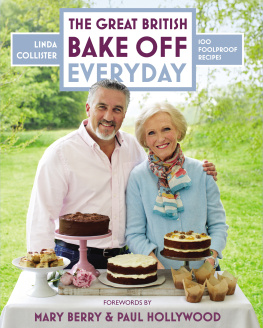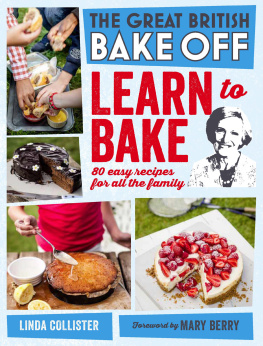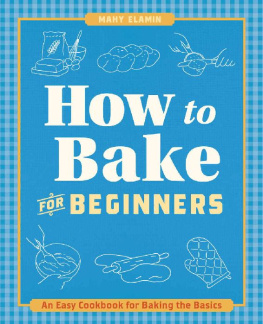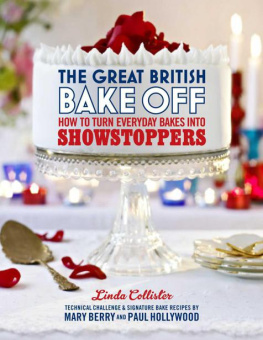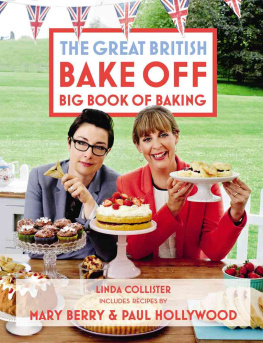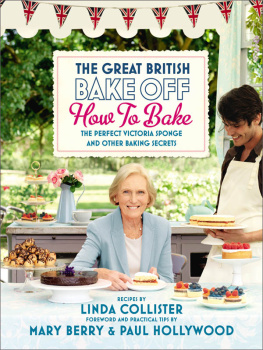CONTENTS
ABOUT THE BOOK
Have you always wanted to make the ultimate chocolate cake for a party? Or fill your home with the wonderful smell of freshly baked bread in the morning? Or even just whip up a quick batch of biscuits when a friend is coming round for tea? Then this is the baking book for you.
The ultimate guide to baking, whether you are a complete novice or a well-practised home cook, The Great British Bake Off: Big Book of Baking provides you with 120 brand-new recipes that are suitable for every occasion and level of skill.
With step-by-step photography to help you through the trickier techniques, as well as the best bakes from the signature, technical and showstopper challenges and all of Mary Berry and Paul Hollywoods Masterclass recipes, you will be able to bake along with the hit BBC series and set yourself challenges that will rival the show!
On your marks, get set, bake!
ABOUT THE AUTHOR
Baker extraordinaire Linda Collister is the author of over 30 books including titles in the bestselling Bake Off series, The Great British Bake Off: Everyday, The Great British Bake Off: How to Bake and The Great British Bake Off: How to Turn Everyday Bakes into Showstoppers.
Love Productions devised and makes the BAFTA award-winning The Great British Bake Off, which is now a global hit with international versions in the US, Australia, Europe and many other countries.
INTRODUCTION
MEETING THIS YEARS BAKERS IS HEARTWARMING: THEY ARE ALL TRUE AMATEURS THEY BAKE FOR THE SHEER LOVE OF IT. WHETHER THE CONTESTANTS HAVE PICKED UP THEIR BAKING SKILLS FROM GRANDPARENTS, PARENTS, FROM SCHOOL OR ARE COMPLETELY SELF-TAUGHT, ALL OUR BAKERS KNOW THAT ANYONE CAN LEARN SOME SIMPLE BAKING SKILLS AND ENJOY DELICIOUS HOME-MADE MEALS AND TREATS.
Apart from the pleasure of watching the faces of loved ones light up as you share your bakes, there are many other joys to home cooking: kneading and shaping bread dough is thoroughly relaxing after a day at work and decorating a cake or icing biscuits is very satisfying plus you get a great loaf or tasty afternoon snacks.
Baking turns the produce from another favourite hobby, gardening, into gloriously healthy and appealing meals: imagine how good it would be to have a bowl of vegetable soup with Jordans Rye and Spelt Rolls or to fill the Ciabatta Rolls from Pauls Technical Challenge with homegrown salad?
If you are fairly new to baking there is plenty of advice and lots of ideas to get you started, and you wont need expensive ingredients or equipment. Experts Paul Hollywood and Mary Berry pass on their wealth of knowledge and many wonderful recipes. Have a go at Pauls Savoury Biscuits or Marys classic Cherry Cake. Many of the recipes come with step-by-step pictures to guide you to success.
On the other hand, if you already enjoy the challenges of baking and are keen to master some new techniques, and find out how to use new ingredients, you can bake along with Mary and Paul as they show you how its done in the masterclasses. Mary has some impressive cakes: her Showstopper Doboz Torte, made from 12 cake layers, will thrill seasoned bakers; and the Swedish favourite, Prinsesstrta is bound to wow baking clubs. Our bakers produced some humdingers too: such as Nancys stunning Summer Pudding Alaska and Iains flavourful Moroccan Plait.
Be inspired by this years batch of lovely bakers; watch their progress and see their confidence grow from week one to the final as they tackle those tricky challenges.
The Great British Bake Off: Big Book of Baking includes much-loved favourites, some with a new twist, and plenty of brand-new baking ideas to try out in the kitchen. So if youre after something to surprise and delight for a once-in-a-lifetime occasion, would like a mouth-watering savoury bake for dinner or simply want a great slice of home-made cake for a mid-afternoon tea break, nows the perfect time to grab a mixing bowl, pick up a spoon and get baking!
A BAKERS GUIDE
Here are explanations for the common terms and techniques that appear in this book.
WHAT DOES IT MEAN?
FOLD: This is a way to delicately combine 2 (or more) ingredients so you dont knock out all the air youve carefully beaten or whisked into a mixture for example, adding sifted flour to a creamed mixture of butter, eggs and sugar for a cake. A large metal spoon or a plastic spatula is best for folding. Turn the spoon so one side cuts down through the mixture. When you touch the bottom of the bowl, turn the spoon upwards and draw it up through the mixture to the top, then flip the spoon over so the mixture flops on to the surface. Give the bowl a quarter turn (so you start folding from a different place) and repeat. Keep lightly cutting, lifting and flopping over until you cannot see any streaks of unmixed ingredients. Use the least number of folding movements possible.
RUB IN: This is how you combine butter and flour when making pastry and simple cake mixtures. Use the fingertips and thumbs of both hands try to keep your palms clean (your fingertips are cooler). Pick up a little of the butter and flour mixture, lift your hands up to the top of the bowl and gently rub your fingers and thumbs together so the mixture is combined as it falls back down into the bowl. Continue doing this until the mixture has a crumb-like consistency. The rubbing-in will add air, which will make the mixture lighter.
SIFT: This means shaking dry ingredients such as flour, a raising agent or icing sugar through a sieve into a bowl. Sifting will remove any lumps, as well as adding air, and it helps to combine ingredients important for raising agents added to flour to be sure they are evenly dispersed (you can also do this in a food processor by pulsing the flour with the raising agents a few times).
WORK: This is a way of saying to mix, stir, blend or combine ingredients using a spoon, plastic spatula or your hands until they have come together (or look smooth, or soft, or thickened), depending on the recipe instructions.
HOW DO YOU DO THIS?
PREPARING TINS
Note: in the equipment information in the recipes, an asterisk has been added to refer to the instructions here.
GREASE AND BASE-LINE A SPRINGCLIP TIN, A DEEP ROUND OR SQUARE TIN, A SANDWICH TIN OR A TRAYBAKE/BROWNIE/RECTANGULAR CAKE TIN: Lightly and thoroughly brush the base and sides of the tin (including the rim) with melted butter. Set the tin on a sheet of baking paper and draw around it, then cut out the circle (or square or rectangle). Turn the baking paper over so that the pencil or pen marks are underneath, and press it on to the base of the tin.
GREASE AND LINE A SPRINGCLIP TIN OR A ROUND DEEP CAKE TIN: Brush the base and sides with melted butter, then cut out 2 rounds of baking or greaseproof paper very slightly smaller than the base of the tin (measure as for base-lining above, then cut inside the drawn line). Also cut out a double-thickness strip of baking or greaseproof paper long enough to go around the tin and stand about 5cm above it. Make a 2.5cm fold along one edge of this strip, then snip diagonally up to the fold at 1cm intervals (it will look like a thick fringe). Press one paper round on to the base of the tin, then place the strip around the inside of the tin so the snipped edge lies flat on the base and the paper is pressed smoothly to the side of the tin (no creases). Brush the paper on the base and the snipped edge of the side strip with a little more melted butter, then press the second round of paper on top. Lightly brush the paper on the base and sides with melted butter to hold it all in place.


